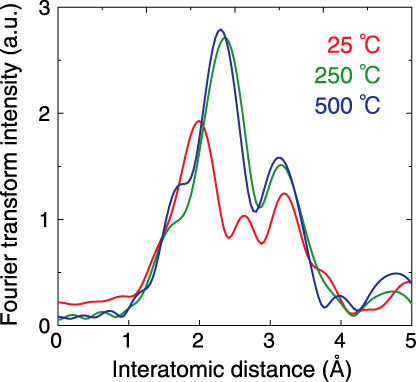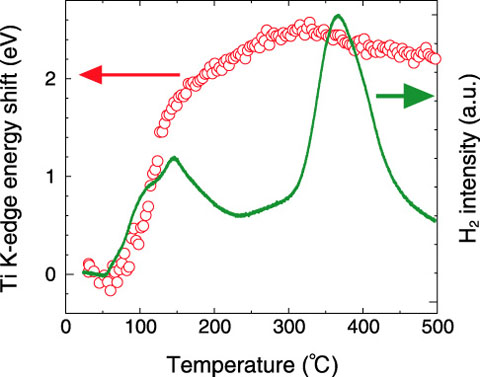
Fig.4-13 Local structure around Ti

Fig.4-14 Ti K-edge energy shift and dehydrogenation curve
Development of advanced onboard hydrogen storage materials with high hydrogen gravimetric density is urgently required. Magnesium borohydride (Mg(BH4)2), which has a hydrogen density of 14.9 wt%, has been regarded as one of the potential hydrogen storage materials. Its potential applications are, however, restricted by its high dehydrogenation temperature (>300 °C). In a recent study, it has been observed that Ti additives lower the initial dehydrogenation temperature of Mg(BH4)2. This result motivated us to clarify the effect of the addition of Ti on the dehydrogenation reaction of Mg(BH4)2.
In this study, we observed the local atomic structure around Ti compounds by the X-ray absorption fine structure (XAFS) technique. Local structural analysis of Ti additives in Mg(BH4)2 indicated that structural transformation occurs between 25 and 250 °C (Fig.4-13). It was important to confirm whether this structural transformation was related to the dehydrogenation reaction.
In order to study the correlation between the structure and the dehydrogenation properties, the XAFS and the dehydrogenation intensity were simultaneously observed (Fig.4-14). The Ti K-edge energy shift showed an abrupt change in the range 100∼150 °C, indicating a structural change in the Ti compound. This temperature range was almost the same as the width of the first peak in the dehydrogenation curve. On the other hand, the K-edge energy shift did not show any change at around 360 °C, where the main peak in the dehydrogenation curve was observed. As a result, we wholly concluded that the local structural change in the Ti compound was directly related to the first dehydrogenation peak, which appeared in the range 100∼150 °C and was not strongly influenced by the main dehydrogenation peak at 360 °C. The dehydrogenation peak in the range 100∼150 °C was revealed to be due to the dehydrogenation reaction of Ti(BH4)3. For this reason, addition of the Ti compound brought about a decrease in the dehydrogenation temperature. Ti(BH4)3 was converted to TiB2, which is more stable.
Simultaneous measurement of the local structure of the Ti compound and the dehydrogenation curve for the hydrogen storage material clearly demonstrates the correlation between the structural change in the additive and the chemical reaction. We believe that such simultaneous measurements would reveal the key component for the development of more efficient hydrogen storage materials.